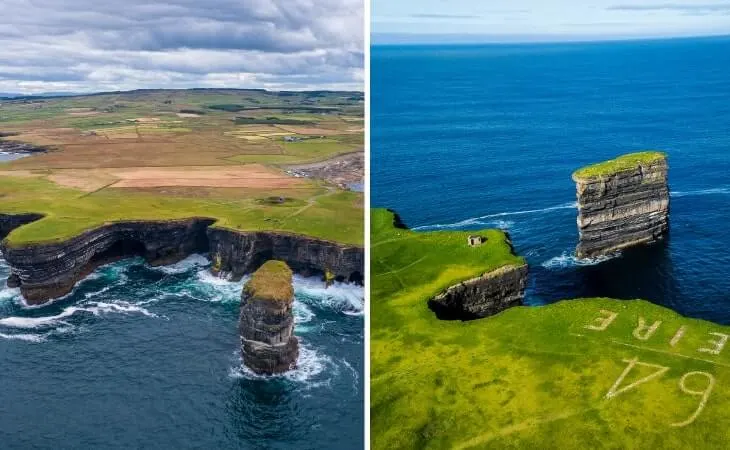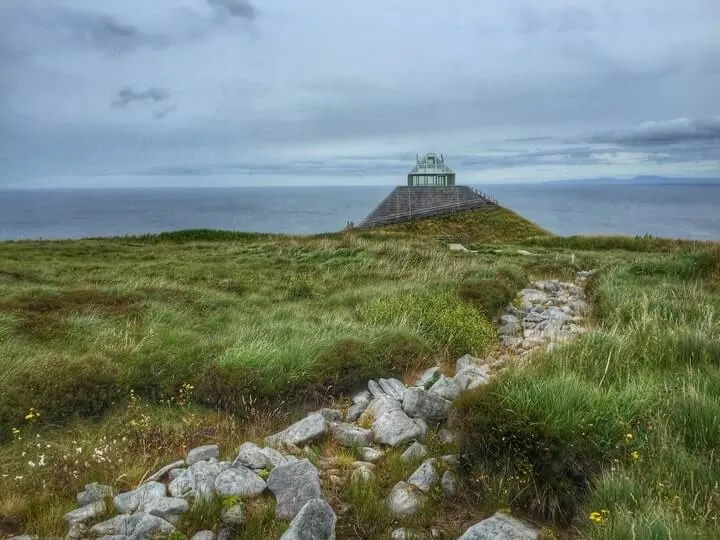The historic Moyne Abbey is one of the more unique places to visit in Mayo.
Moyne Abbey is a 560-year-old friary complex with a church, tower, well-preserved cloisters and many supporting buildings still surviving relatively intact.
Occupying a stunning coastal location, it’s an wonderful place to have a nosey around, with several unique features worth looking out for.
Some quick need-to-knows before visiting Moyne Abbey in Mayo

Photo by shawnwil23 (Shutterstock)
So, a visit to Moyne Abbey near Ballina isn’t overly straightforward, and that’s thanks to the fact that there’s no parking here… which isn’t ideal. Here are some need-to-knows.
1. Location
Moyne Abbey is located on the coast of County Mayo, about 3km east of Killala and 12km north of Ballina. The site overlooks the mouth of the River Moy and is accessed via a right-of-way across private land (it is not directly accessible from the road). The idyllic location overlooks the Bay of Killala, the Moy River and the Ox Mountains beyond.
2. A whole lot of history
Moyne Abbey is a National Monument and, even in ruins, it is a most imposing building. Founded as a Franciscan Abbey in 1462, it was burnt in 1590 as part of the Protestant Reformation in Ireland.
3. Parking (warning)
Moyne Abbey is not a developed tourist site. There is no dedicated parking so visitors have to park carefully on the roadside. Care should be taken not to block the road or any gateways. Never park on or near a bend in the road.
4. The entry point
The right of way is marked by a sign that actually says “private property – beware of the bull”. So, yes, you’ll have to visit at your own risk! Here’s where to find the entry point on Google Maps.
5. Another warning
There’s no real path to Moyne Abbey, and you’re walking through fields for the entire journey to it. This can result in ruined shoes, so bring old ones if you have some to spare.
A speedy history of Moyne Abbey

Moyne Abbey was founded in 1460 by McWilliam Bourke, part of the powerful de Burgo / Burke family.
It was said that he was led by a dove to the low-lying site which was the site of the great Battle of Moyne in 1281.
He took this as an omen and donated the land to the Franciscans for the construction of a friary.
Moyne Abbey buildings
Built in Irish Gothic style, the friary included a square six storey tower with battlements and a traditional cruciform church, chapel and cloisters.
It had a vaulted chapter room, sacristy, dormitories, infirmary, kitchen, refectory and a mill built over a stream.
The order flourished with over 50 novices and friars following the strict way of life for the next 130 years.
Disaster and survival
As part of the Protestant Reformation (1590-1641) Sir Richard Bingham, English Governor of Connacht, burnt the friary in 1590.
He held a personal hatred of the Burke family and was determined to destroy their wealth.
The Cromwellian soldiers murdered the friars and violated the altars. However, the friary survived and continued to operate until the 18th century when the buildings where no longer habitable.
Why Moyne Abbey is worth a visit

Photo by Johannes Rigg (Shutterstock)
Despite being over 550 years old and roofless, these ecclesiastical ruins are well preserved and very impressive.
The mediaeval complex remains largely intact so visitors can walk through each building imagining the peaceful life led by the Franciscan friars.
Today, the walls and buildings of Moyne Abbey remain an atmospheric place to visit. The complex includes a church, a six storey tower, chapel with cloisters, remains of a vaulted chapter room, sacristy, dormitories, infirmary, kitchen, refectory and a mill.
Very old ship etchings
On the west gable of the abbey, on either side of the doorway and on a side wall, a collection of ships have been gouged into the walls.
These simple drawings probably date back to the 16th century and may have been a nod of appreciation to the Galway merchants who were benefactors of the friary. These “Moyne Ships” were discovered when the plaster fell off as a result of weathering.
A host of other interesting features
Beyond the cloisters and the etchings, other interesting features worth seeking out include the remarkably ornate window tracery that would have been part of the main church. Note the west doorway of the church which is in Renaissance style. It was probably added in the 17th century.
Underneath the east windows in the transept of the church there are recesses of two side chapels. Between them is an interesting feature – a very small space recessed into the thickness of the wall.
It was probably the sacristy where sacrament vessels and altar vestments would have been stored. In the grounds, the millrace still can be seen. It would have fed water from the stream to drive the mill-wheel as part of the now-ruined mill.
The “Ghostlore”
Irish legend has it that Moyne Abbey had rooms filled with skulls and bones, and this led to tales of strange noises and ghostly goings-on after dark.
One story tells of a young chapel clerk, Peter Cumming, who in a drunken boast bet his friends a golden guinea that he could fetch a skull from Moyne Abbey and put it on the table.
Drink no doubt emboldened him to make the trip to the abbey, but just as he reached out for one of the skulls he heard a voice. He looked up to see the ghost of his grandfather chastising him for removing the skull.
Peter promised to return the skull after collecting his guinea and the apparition disappeared. Peter did present the skull to his friends, collected his guinea and, good as his word, returned and buried the skull properly.
Things to do nearby
One of the beauties of Moyne Abbey is that it’s a short spin away some of the best things to do in Mayo.
Below, you’ll find a handful of things to see and do a stone’s throw from Moyne Abbey. If you’re feeling peckish, you’re a short, 15-minute drive from many of the best restaurants in Ballina.
1. Rosserk Friary (9-minute drive)

Just 5km northwest of Moyne is Rosserk Friary, one of the finest preserved Franciscan Friary in Ireland. Built in 1440, it was also burnt by Sir Richard Bingham as part of the Reformation. The Irish Gothic church is well-preserved with a single-aisle nave, two chantry chapels and a bell tower. On the upper floor are the remains of the dormitory, refectory and kitchen with two fireplaces still evident.
2. Belleek Woods (20-minute drive)

Photo by Bartlomiej Rybacki (Shutterstock)
Just north of Ballina, Belleek Woods are now managed by Coilte Teoranta, an Irish state-owned forestry company. The 1000-acre woods are one of the largest urban forests in Europe and provide a peaceful retreat and walking trails beside the River Moy for hiking, bird-spotting and wildlife. There’s also plenty of things to do in Ballina, while you’re closeby.
3. Belleek Castle (15-minute drive)

Photo via Belleek Castle on Facebook
Within Belleek Woods, the magnificently restored Belleek Castle is now one of the most unique hotels in Mayo. Built by the Knox-Gore family in 1825, this neo-Gothic castle remained in the family for several generations before being sold in 1942. It was used as a hospital and military barracks before being magnificently restored by Marshall Doran. It is now packed with treasures and is well worth a guided tour.
4. Downpatrick Head (30-minute drive)

Photos by Wirestock Creators (Shutterstock)
Just north of Ballycastle, Downpatrick Head is one of the Discovery Points on the Wild Atlantic Way. It’s most famous for the sea stack, Dun Briste, just 200 metres offshore. The headland is where St Patrick founded a church, now in ruins. See a statue of the patron saint, a WW2 lookout post and a spectacular blowhole!
5. Ceide Fields (27-minute drive)

Photo by draiochtanois (shutterstock)
The Ceide Fields are a a remarkable neolithic site on cliffs 113 metres above the Atlantic Ocean. The stone-enclosed fields are thought to be the oldest-known field system in the world and along with foundations of a settlement were discovered by accident in the 1930s. It is now a top visitor attraction with tours and a Visitor Centre.

